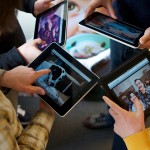Terry Heick: Obsolescence, Proliferation & Other Harmful Trends In Education Technology
By Wired Academic on March 7, 2013
Blended Learning, Domestic, Education Quality, Friend, Fraud, or Fishy, K-12, Opinion, Required, Teachers, Technology, Universities & Colleges
 not an egg via Compfight
not an egg via Compfight
This post “3 Hurtful Trends In Educational Technology–And How To Mitigate Their Effects” originally appeared on TeachThought.
By Terry Heick, Columnist
Let’s play word association for a moment.
When you read the word teacher, what’s the first image that pops in your head?
How about school?
What about technology?
For me, technology is all about change. (I know that’s not really quite right when you consider the relative nature of technology and all of its definitions, but this is word association, not a Socratic Seminar.)
And with that rate of change comes challenges for all users–challenges that range from those consumer-based to those ecological in nature.
There is a downside to all this progress after all. Such as:
1. Proliferation
Device proliferation is a fancy way of saying that there are a lot of gadgets out there these days. So many devices from so many manufacturers that essentially do the same thing.
A lot of pencils, laptops, or Klondike bars are a good thing: thirty just slightly different tablets are not. This kind of proliferation puts tremendous strain on developer resources, district IT time, and educator mental energy. In addition there are brands within and across hardware and software, the two biggest in town being Android (Google) and iOs (Apple). Your Android (Gmail) email app may not work well with your fancy new Apple tablet, lacking notifications, badges, or even push functionality, while many of your Apple apps may not even be available on an Android tablet.
It’s one thing when projectors and smartboards start multiplying. A projector is a projector, and will likely work with almost any smartboard. But when more complex, more expensive pieces that are used directly by students begin to increase more in quantity than quality, trouble is brewing. Because consumer demand is so high, there are literally scores of desktop PCs, laptops, netbooks, iPads, smart televisions, smartphones–and now even ‘tweener phones that are either small tablets or big phones (Samsung calls theirs a “note”)–that each market themselves as indispensable.
And they’re all built for the same purpose: To allow for the consumption and production of digital media.
Mitigation: While it each piece of hardware may seem like a must-have, think not technology-forward, but learning backwards. That is, rather than thinking of all the cool tricks a gadget can perform, think of what problems or barriers there are in the learning process, and then look to which hardware pieces most dutifully fill that role.
Even if the choices aren’t sexy.
2. Fragmentation
Fragmentation refers to different generations of software for the same operating system across devices.
For example, your average Android phone may come with 2.2, 2.3, 3.0 or 4.0 of the Google mobile operating system. This is usually an after-thought for end-users like you and I. But big-picture, this is a challenge for everyone, from those who make purchasing decisions in schools and districts, to those who use the devices day in and day out.
Imagine being an app developer and having to create programs that work (well) with not just one operating system, but sometimes up to a half-dozen, each completely customizable on by end users. (This, among others reasons, is why Apple limits such customization and fragmentation.)
With Windows products, this is less of an issue. Few schools and districts are still running Windows Vista, much less Windows XP or, (*gulp*) Me. Apple products are almost on all latest-generation iOS builds as well, though Boy Genius Report clarified that with iOS 6, Apple may finally have to deal with it as an issue, explaining “Apple’s impressive 3D Flyover feature and turn-by-turn voice navigation found within its new Maps app will only work on A5-powered devices, meaning the iPhone 4S, iPad 2 and the new iPad. To make matters worse, the iPhone 3GS doesn’t support FaceTime and it won’t be able to handle offline reading, shared Photo Streams, VIP lists or Flagged Smart mailboxes.”
The issue of fragmentation is significant on Android, with less than 10% of Android smartphones and tablets running the latest version of Android.
Mitigation: While laptops like Google Chromebooks make this a non-issue due to their cloud-based operation, the best way to mitigate the effects of fragmentation in your learning environment is to let students learn to work around the issue themselves, especially in BYOD-situations. This may sound like crude advice, but it’s a reality they’ve likely faced before, and is an authentic barrier they likely know more work-arounds for than you do.
3. Obsolescence
This threat is perhaps the most pernicious. While an issue for most products short of books and antiques, in the technology world obsolescence can not only cost money, but can threaten the quality of skill-building learners get with hands-on use. We buy our device, and expect it to age gracefully. We do not want to hear that the latest-and-greatest app won’t work on our generation iPad.
Whereas previous generations of technology had a habit of fending for themselves (e.g., typewriters, telephone, modern combustion engine), the modern technology industry has seemingly developed an odd desire to replace and cannibalize itself constantly. Giving users access to dated technology may be okay on a cognitive level, but presents several practical conflicts, including maintaining credibility with students.
Part of the issue at work is that mass market trends are bleeding over into the classroom more strongly than ever before. Stores and websites and operating systems and turtle-necked geniuses are peddling their wares to everyone at all times through social media and digital technology. Students show up in classrooms demanding the latest technology as a matter of both style and (perceived) function. While classrooms used to be ahead of the technology at home, any students with a recent Android or iPhone smartphone in their pocket has 75% of the potential of a functioning computer lab at school. In many ways, the tides have turned.
Mitigation: If there was an easy fix for this, landfills wouldn’t be full of old electronics. But among the simplest ways to mitigate the effects of obsolescence is to use web and cloud-based apps and software that are modest in their hardware demands–memory and processor speed, for example. This allows devices to be used longer while using latest-generation software (in app form) that work from browsers or smartphones. (No more waiting 5+ years between releases of Microsoft Word)
It can also be helpful to implement a BYOD policy, and like #2, help the learners find work-around to using old technology.
Terry Heick is an educator, husband, and father of three children. He is interested in improved social capacity through the design of progressive learning forms. This article first appeared at TeachThought.
Related Posts
Internet highlights
- Online Casinos
- Best Non Gamstop Casinos In The UK
- Casinos Online España
- Non Gamstop Casino
- Online Casinos UK
- Best Online Casino Canada
- Non Gamstop Casinos
- Casino En Ligne Fiable
- Non Gamstop Casino Sites UK
- Non Gamstop Casino
- Casinos Not On Gamstop
- Non Gamstop Casinos
- Best UK Casinos Not On Gamstop
- Sites Not On Gamstop
- Casinos Not On Gamstop
- Sites Not On Gamstop
- Non Gamstop Casinos
- UK Online Casinos Not On Gamstop
- Betting Sites
- Uk Horse Racing Betting
- Top UK Casino Sites
- Casino Non Aams Sicuri
- Casino Non Aams Sicuri
- Casinos Not On Gamstop
- Crypto Casino
- Meilleur Casino En Ligne
- Sites De Paris Sportifs Autorisés En Belgique
- Nhà Cái Uy Tín
- ブック メーカー 日本 おすすめ
- Nouveau Casino En Ligne 2026
- Casino En Ligne Argent Réel


Tips & Pitches
Latest WA Features
-
Trend: Corporate U Employers Offering Just In Time Education To Workers
-
Subterfuge & Skullduggery In The College Rankings Game
-
“Instreamia” Shakes Loose Moss By Launching Spanish Language Mini-MOOC
-
Jörn Loviscach: A German Math Teaching Sensation Emerges On YouTube & Udacity
-
Open University Enters Battle Of The MOOCs, Launches “FutureLearn”
Blended Learning, Domestic, Education Quality, For-Profit, Friend, Fraud, or Fishy, K-12, Personalized Learning, Public, Regulatory, Required, Universities & Colleges - Jun 19, 2013 - 2 Comments
Kamenetz: Jeb Bush As Controversial Leader Of Aspen Task Force on Learning & The Internet
More In For-Profit
- Columnist Ryan Craig: The Best Of Times Could Return As For-Profit Edu Invests
- Bubble Analysis: Trace Urdan on Why This Era of Ed Investing Could Be Different
- A Blended Path? How American Honors Cuts Cost of Four Year Degree by Over a Third
- New For-Profit Alert: RonPaul.edu?
- Uncle Sam Sequester Suspends Tuition Assistance For Soldiers, APEI Quakes
Domestic For-Profit Legislation Regulatory Required Universities & Colleges
Domestic, MOOCs, OER - Open Educational Resources, Personalized Learning, Required, Startups, Technology, Universities & Colleges - Jul 8, 2013 - 0 Comments
TexasTribune: Thousands Signed Up For UT-Austins First EdX Courses
More In Technology
- Anne Collier: The Finer Points For Parents On Maximizing Minecraft’s Potential
- 5 Questions With An EdTech Startup: Hannes Klöpper of Berlin-based MOOC provider ‘iversity’
- Innovative Programs Use Data & Interventions To Steer Smart, But Poor, High Schoolers Toward College
- Kamenetz: What Mozilla Ignite Can Do & Might Do For Learning
- Kamenetz: Talking To A Teacher About Teaching With iPads & Tablets
Blended Learning Domestic Education Quality Ereaders Friend, Fraud, or Fishy Interview K-12 Personalized Learning Publishers & Curriculum Required Teachers Technology
Blended Learning, Domestic, Education Quality, Ereaders, Friend, Fraud, or Fishy, Interview, K-12, Personalized Learning, Publishers & Curriculum, Required, Teachers, Technology - Jun 27, 2013 - 0 Comments
Kamenetz: Talking To A Teacher About Teaching With iPads & Tablets
More In Friend, Fraud, or Fishy
- Kamenetz: Jeb Bush As Controversial Leader Of Aspen Task Force on Learning & The Internet
- Anne Collier: Disliking The OverAbundance of “Likes” In Social Media Gamification
- Transformational? The “Ifs, Ands or Buts” About Blended Learning
- Terry Heick: Obsolescence, Proliferation & Other Harmful Trends In Education Technology
- Important Early Questions Over Obama’s Early Childhood Program Ambitions
Cost of Education Domestic Early Childhood Education Education Quality Friend, Fraud, or Fishy Legislation Minorities Parents Public Required









Reply